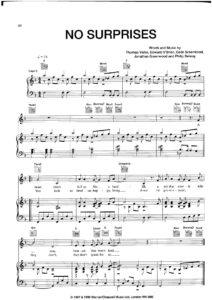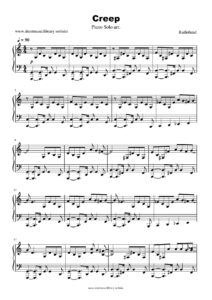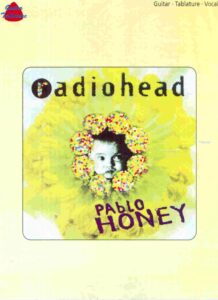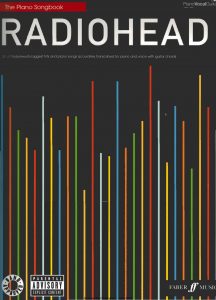Table of Contents
Come join us now, and enjoy playing your beloved music and browse through great scores of every level and styles!
Can’t find the songbook you’re looking for? Please, email us at: sheetmusiclibrarypdf@gmail.com We’d like to help you!
Radiohead: Creep Easy Piano Solo Arr.

Best Sheet Music download from our Library.
Please, subscribe to our Library.
If you are already a subscriber, please, check our NEW SCORES’ page every month for new sheet music. THANK YOU!
Radiohead: The Definitive Guide to One of Rock’s Most Innovative Bands
Formed in 1985 in Abingdon, Oxfordshire, England, Radiohead has become one of the most critically acclaimed and influential rock bands of all time. Known for their genre-defying evolution, experimental approach, and deeply introspective lyrics, they’ve redefined alternative music over three decades.












Browse in the Library:
Or browse in the categories menus & download the Library Catalog PDF:
Band Members
- Thom Yorke – Lead vocals, guitar, piano, electronics
- Jonny Greenwood – Lead guitar, keyboards, orchestration, electronics
- Ed O’Brien – Guitar, effects, backing vocals
- Colin Greenwood – Bass, synths
- Philip Selway – Drums, percussion
(Original name: On a Friday—changed to Radiohead in 1991 after signing with EMI.)
Musical Evolution & Key Albums
1. Early Years: Grunge & Britpop Influences (1990s)
- Pablo Honey (1993)
- Breakout hit: “Creep” (a grunge-inflected anthem of alienation).
- Initially dismissed as one-hit wonders, but the album hinted at deeper songwriting.
- The Bends (1995)
- Produced by John Leckie (Stone Roses, Pink Floyd).
- Defined their melancholic yet explosive alt-rock sound.
- Key tracks: “Fake Plastic Trees,” “High and Dry,” “Street Spirit (Fade Out).”
- OK Computer (1997)
- A landmark in rock history—often ranked among the greatest albums ever.
- Themes: Technology, alienation, dystopia.
- Key tracks: “Paranoid Android,” “Karma Police,” “No Surprises.”
- Won the Grammy for Best Alternative Album (1998).
2. Experimental & Electronic Shift (2000s)
- Kid A (2000)
- Radical departure—abandoned guitars for glitchy electronics, jazz, and ambient.
- Influenced by Warp Records, Aphex Twin, Miles Davis.
- Key tracks: “Everything in Its Right Place,” “Idioteque,” “How to Disappear Completely.”
- Grammy for Best Alternative Album (2001).
- Amnesiac (2001)
- Recorded during Kid A sessions—more jazz-influenced & abstract.
- Key tracks: “Pyramid Song,” “Knives Out,” “Like Spinning Plates.”
- Hail to the Thief (2003)
- A mix of electronic experimentation and rock aggression.
- Political themes (post-9/11 anxiety).
- Key tracks: “There There,” “2 + 2 = 5,” “A Punchup at a Wedding.”
- In Rainbows (2007)
- “Pay-what-you-want” digital release—revolutionized music distribution.
- A return to warmth & melody, blending rock and electronica.
- Key tracks: “Reckoner,” “Weird Fishes/Arpeggi,” “Jigsaw Falling Into Place.”
3. Later Work: Art-Rock & Orchestral Explorations (2010s–2020s)
- The King of Limbs (2011)
- Rhythmic, loop-based, minimalist.
- Inspired by Flying Lotus, dubstep, and organic textures.
- Key tracks: “Lotus Flower,” “Codex,” “Separator.”
- A Moon Shaped Pool (2016)
- Orchestral, haunting, deeply emotional.
- Features Jonny Greenwood’s string arrangements (influenced by his film scoring work).
- Key tracks: “Burn the Witch,” “Daydreaming,” “True Love Waits.”
- Recent Work & Side Projects
- Thom Yorke’s solo work (The Eraser, ANIMA).
- Jonny Greenwood’s film scores (There Will Be Blood, The Power of the Dog).
- The Smile (Yorke & Greenwood’s side project with jazz drummer Tom Skinner).
Key Musical Innovations
Genre-Blending – From alt-rock to electronica, jazz, classical, and IDM.
Production Techniques – Use of sampling, modular synths, algorithmic composition.
Lyrical Themes – Existential dread, political dissent, climate change, human disconnection.
Live Performances – Known for rearranging songs radically in concert.
Cultural Impact & Legacy
- OK Computer & Kid A are frequently ranked among the greatest albums ever (Rolling Stone, Pitchfork, NME).
- Pioneers of digital music distribution (In Rainbows’ pay-what-you-want model).
- Influenced bands like Muse, Arcade Fire, The National, Coldplay (early), and countless electronic artists.
- Frequently cited by critics as the “Radiohead of [their genre]”—a shorthand for artistic ambition and reinvention.
Essential Deep Cuts & B-Sides
- “Talk Show Host” (Romeo + Juliet soundtrack)
- “The Daily Mail” (From The King of Limbs era)
- “Spectre” (Unused James Bond theme)
- “Man of War” (Finally released in 2017’s OKNOTOK reissue)
Why Radiohead Matters
Few bands have reinvented themselves so drastically while maintaining critical and fan acclaim. From the raw angst of “Creep” to the orchestral despair of A Moon Shaped Pool, Radiohead remains the defining art-rock band of their generation.
Want to discover more about Radiohead? Dive into:
- Their 1997 Meeting People Is Easy documentary (on the OK Computer tour’s toll).
- Jonny Greenwood’s film scores for Paul Thomas Anderson.
- The Smile’s albums (A Light for Attracting Attention).
Radiohead’s “Creep” – The Definitive Breakdown
“Creep” is the song that launched Radiohead into the global spotlight—a haunting, self-loathing anthem that became an unlikely alt-rock classic. Despite the band’s later ambivalence toward it, the track remains a cultural touchstone. Here’s everything you need to know:
1. Origins & Writing
- Year Written: 1992 (before Pablo Honey was recorded).
- Primary Writers: Thom Yorke (lyrics, melody) + Radiohead (music).
- Inspiration:
- Yorke wrote it after seeing a girl he liked at a club but feeling too insecure to approach her.
- The “I’m a creep, I’m a weirdo” refrain reflects his struggles with alienation and self-doubt.
- Musically, it was influenced by The Hollies’ “The Air That I Breathe” (1974), leading to a later songwriting credit for Albert Hammond and Mike Hazlewood.
2. Musical Structure & Innovation
- Key: G major (verses) → B major (chorus) – an unusual shift for a rock song at the time.
- Dynamics: Starts soft, then explodes with Jonny Greenwood’s crushing guitar noise before the chorus.
- Iconic Guitar Moment: Greenwood’s three dissonant strikes before the chorus—meant to sound like “a glitch in the system.”
- Bass & Drums: Colin Greenwood and Phil Selway provide a slow, brooding rhythm that amplifies the song’s tension.
3. Release & Initial Reception
- First Release: 1992 (as a single, later included on Pablo Honey, 1993).
- Initial Flop: It bombed in the UK upon release, peaking at #78.
- Unexpected Breakthrough:
- Gained traction on Israeli radio, then spread globally.
- Re-released in 1993, reaching #7 in the UK and becoming a US alt-rock hit.
4. Why Radiohead Hated (Then Reclaimed) It
- Early Resentment:
- The band felt pigeonholed as “the Creep band.”
- Yorke called it “the most depressing song ever” and refused to play it for years.
- Later Reappraisal:
- Played it live again in the 2000s, often in reworked, slower versions.
- Acknowledged its role in their career, though they still prefer deeper cuts.
5. Cultural Impact & Legacy
Defined 90s Alt-Rock – Alongside Nirvana’s “Smells Like Teen Spirit,” it became an anthem for outsiders.
Enduring Popularity – Over 1.6 billion streams on Spotify (their most-played song).
Covers & Samples – Famous versions by:
- Prince (slow, soulful rendition)
- Scala & Kolacny Brothers (choral cover, used in The Social Network trailer)
- Postmodern Jukebox (jazz twist)
Memes & Irony – Despite its angst, it’s now a self-aware meme (e.g., karaoke staple, TikTok trends).
6. Live Performances & Evolutions
- Early 90s: Raw, aggressive (see Live at the Astoria, 1994).
- 2000s: Stripped-down, acoustic or piano-driven (e.g., 2003 Glastonbury).
- 2016+: Occasionally played as a nostalgic crowd-pleaser.
7. Bizarre Fact
- NASA Played It in Space – In 2013, astronauts on the ISS woke up to “Creep” as their morning alarm.
“Creep” is a paradox: a song Radiohead outgrew, yet one that refuses to fade away. Its raw vulnerability and explosive catharsis still resonate, proving that even a band as forward-thinking as Radiohead couldn’t escape the shadow of their first masterpiece.
Want more? Compare it to:
- “How to Disappear Completely” (their anti-“Creep”)
- “Karma Police” (another iconic self-loathing anthem)
- The Smile’s “Thin Thing” (how Yorke’s angst evolved).
